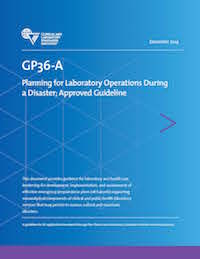Members Login

Channels
Special Offers & Promotions
CLSI Publishes a New General Laboratory Standard Planning for Laboratory Operations During a Disaster
The Clinical and Laboratory Standards Institute (CLSI) has published a new document, Planning for Laboratory Operations During a Disaster; Approved Guideline (GP36-A).
 This document provides guidance for laboratory and health care leadership for development, implementation, and sustainment of effective emergency preparedness plans (all hazards) supporting nonanalytical components of clinical and public health laboratory services that may pertain to various natural and manmade disasters.
This document provides guidance for laboratory and health care leadership for development, implementation, and sustainment of effective emergency preparedness plans (all hazards) supporting nonanalytical components of clinical and public health laboratory services that may pertain to various natural and manmade disasters.
This document follows a preparedness planning process recommended by business continuity planning professionals, which is intended to take the reader from the early phases of preparedness planning through mitigation, preparedness, response, and recovery, while following the quality management approach for policies and procedures (see CLSI document QMS01 for more information.)
GP36-A is intended to lead the reader through a logical and sequential approach to the emergency planning process. GP36-A is a useful resource intended primarily to help users navigate the US requirements for disaster preparedness; however, the document may be generally applied in global settings.
This document gives an overview of typical emergency management planning at the hospital and community level regarding what can be expected outside of the laboratory that may impact the laboratory during disaster operations. The document presents a detailed roadmap to emergency operations plan (EOP) development, maintenance, and continued improvement. Public health assets are discussed including a section devoted to pandemic influenza planning.
“Overall, the document should enhance the ability of laboratory emergency planners to mitigate and prepare for emergencies within their own laboratory, and to integrate their plans with facility and community assets,” noted GP36-A Document Development Committee Chairholder, Thomas L. Williams, MD, FACB, FASCP, FCAP, of Methodist Hospital Pathology in Omaha, Nebraska, USA. “GP36-A looks at a fundamentally or primarily nonlaboratory event, but from a laboratory perspective. The document intends to be realistic and useful to laboratory professionals. It reflects development by people who are actually involved in emergency planning for health care, who can understand the practical challenges they may face.”
General aspects of this document could pertain to hospital laboratories, independent referral laboratories, and public health laboratories. Additional emphasis is given on how to interact with governmental Laboratory Response Networks. This document should be used as a guideline to develop a local or site-specific EOP.
Media Partners


